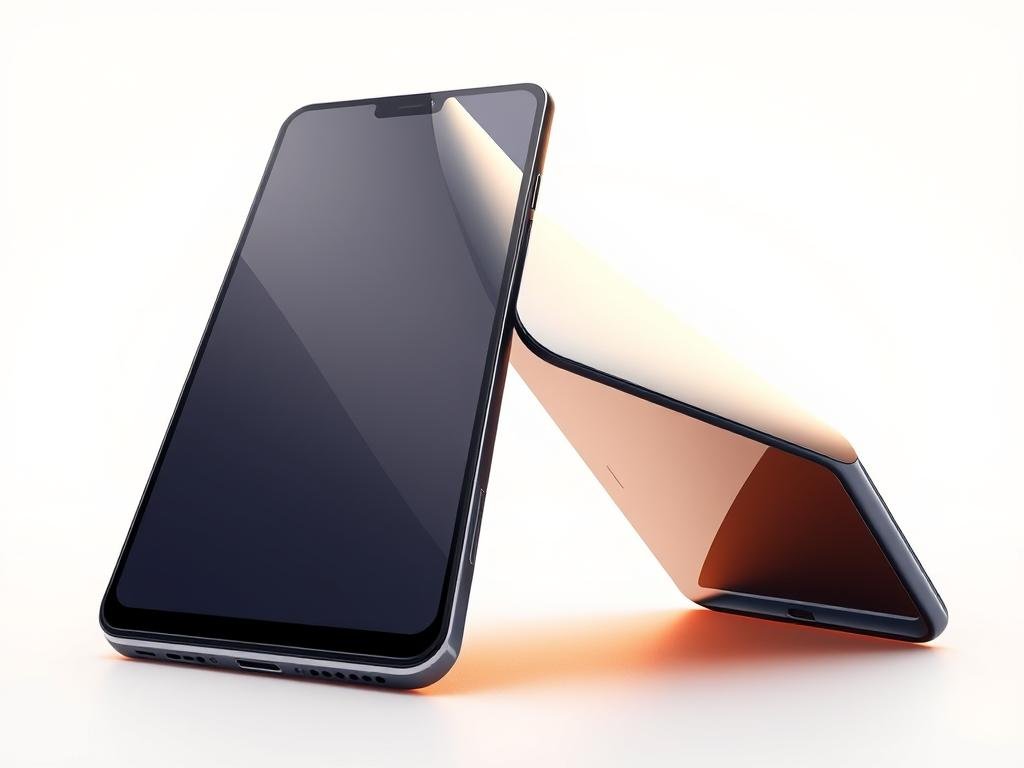Smartphones are on the verge of a big change, with foldable phones at the forefront. As we explore the future of innovative folding solutions, it’s clear that the tech is moving fast.
New shapes like rollable and tri-fold phones are changing what mobile devices can do. But are people ready for these groundbreaking designs?
Big names in tech are working hard to make these phones better and more durable. Check out our latest article on foldable phones in 2025 to see where the market is headed.
Key Takeaways
- The foldable phone market is expanding rapidly.
- New form factors like rollable and tri-fold phones are emerging.
- Major manufacturers are driving innovation in foldable technology.
- Consumer adoption rates are on the rise.
- Durability and user experience are improving with advancements in screen technology.
What Are Foldables?
Have you heard about foldables? They’re a new kind of smartphone that can change shape. This lets users adjust their device to fit their needs.
Definition of Foldable Technology
Foldable tech uses flexible materials, like OLED displays, that can bend without breaking. This lets devices fold or change shape. They become more compact when not in use.
There are two main types of foldables. The book-style foldable unfolds into a bigger screen. The flip-style foldable looks like old flip phones.
Brief History of Foldable Devices
The idea of foldable devices has been around for years. The first foldable phone, the Royole FlexPai, came out in 2018.
Big names like Samsung and Huawei soon followed. They introduced their own foldables, like the Samsung Galaxy Z Flip and Huawei Mate X.
| Year | Device | Manufacturer |
|---|---|---|
| 2018 | Royole FlexPai | Royole |
| 2019 | Samsung Galaxy Fold | Samsung |
| 2020 | Huawei Mate Xs | Huawei |
The Rise of Foldable Phones
Foldable phones are changing how we use our devices. They offer both portability and lots of features. This shift is making smartphones more innovative and useful.
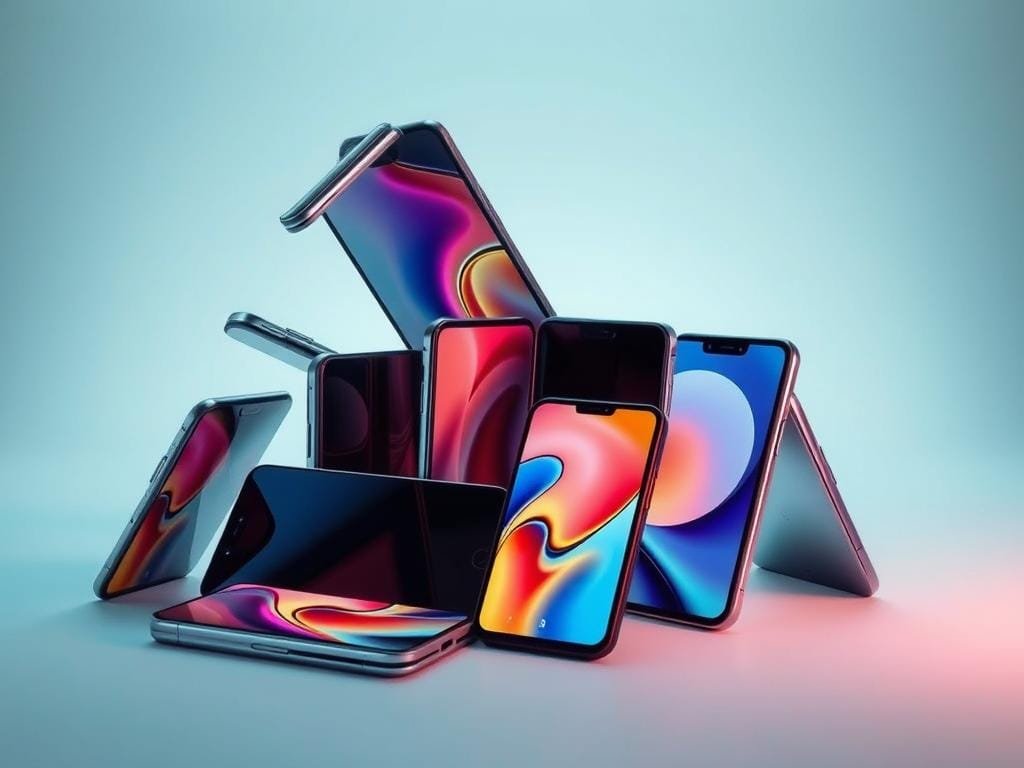
Key Players in the Market
Big names like Huawei and Samsung lead the foldable phone market. Huawei is ahead, says International Data Corporation. Samsung is close behind, always introducing new designs and features.
Other companies are joining in, making the market more competitive. This competition drives innovation and makes foldable phones more available to everyone.
Major Innovations in Design
Foldable phones have cool designs. They come in different shapes, like clamshells and flexible screens. This variety attracts many buyers.
Designs aren’t just about looks; software is also getting a boost. Some phones let you use multiple apps at once. This boosts productivity.
Consumer Reception and Trends
People generally like foldable phones. They love how they can switch between small and big screens. This is great for those who want both size and convenience.
It seems like people want devices that fit their lifestyle. Foldable phones are perfect for this. As technology gets better, we’ll see more foldable products, like laptops and tablets.
Thinking about getting a foldable phone? It’s good to know the pros and cons. With big brands always improving, the future of foldable phones looks bright.
Advantages of Foldable Devices
Foldable devices are changing how we use technology. They offer benefits that regular smartphones can’t. You’ll find they make using technology more fun and flexible.
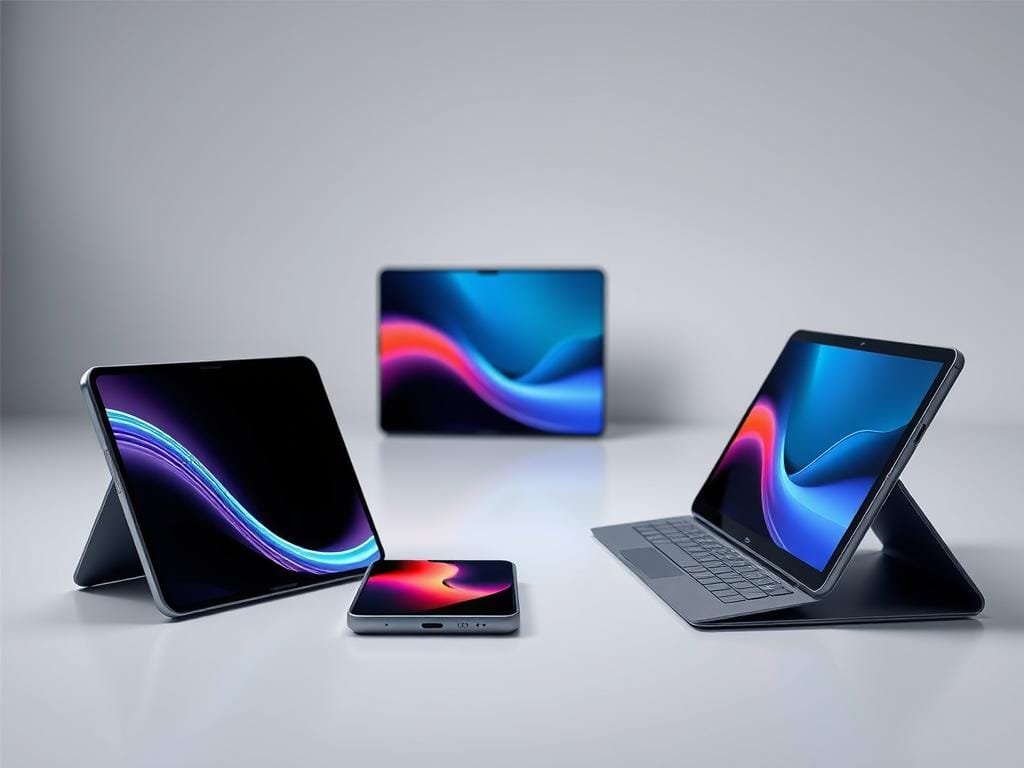
Enhanced Portability
Foldable devices are great because they’re super portable. They fold up like folding chairs and fit in your pocket. This means you can have a big screen when you need it and be small when you don’t.
Multitasking Capabilities
Foldable phones are also great for multitasking. When you unfold them, you can use more apps at once. This is like how collapsible furniture can change to fit your needs. Whether you’re working, playing games, or browsing, foldables make multitasking easier.
Innovative User Experience
Foldable devices offer a unique user experience. They mix being small with having a big screen. For example, you can watch videos or read on a big screen and then fold it up for easy storage. For more on mobile tech, check out 5G mobile development resources.
In summary, foldable devices have many benefits. They’re easy to carry, great for multitasking, and offer a new way to use technology. As tech keeps getting better, foldables will be key in the future of mobile devices.
The Challenges Facing Foldables
Foldable technology is growing, but it faces many challenges. As a user, you might know their benefits. Yet, there are big hurdles to overcome before they become common.
Durability Concerns
Durability is a big worry with foldables. The hinge, though new, is a weak spot. To fix this, makers are testing and improving designs.
They’re using strong materials to make hinges and screens last longer. This is a step towards making foldables more durable.
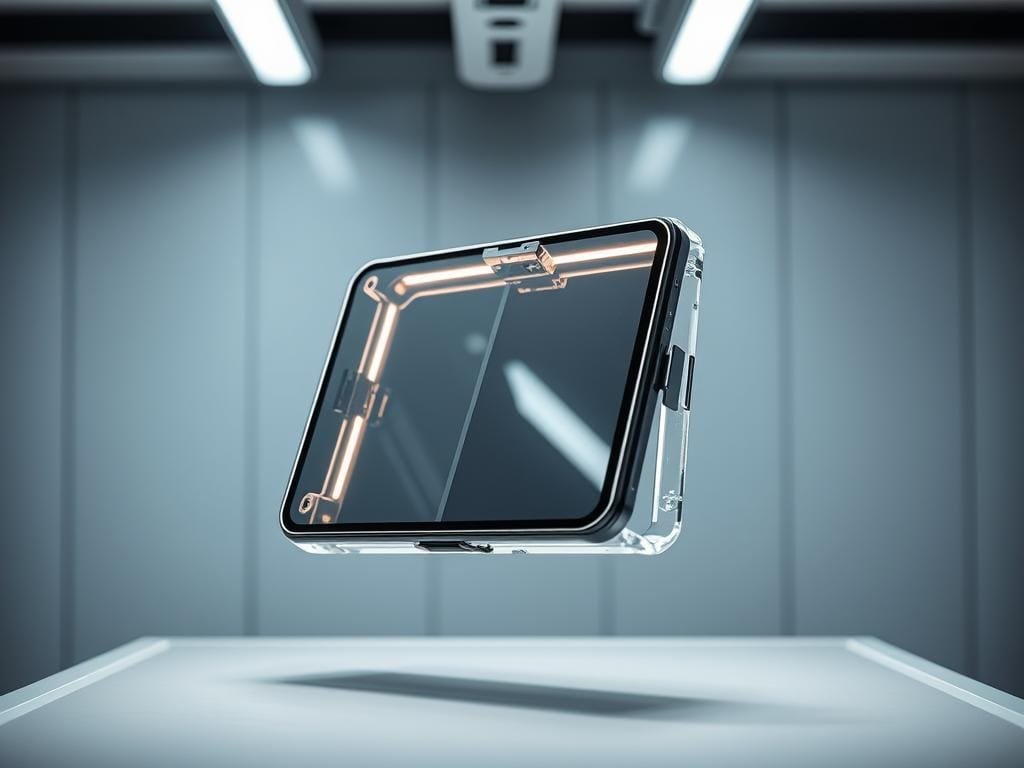
Software Compatibility Issues
Another problem is software. Many apps don’t work well on foldables. This makes using them less enjoyable. Forbes says app developers face big challenges with foldables.
Production Costs and Scalability
Folding phones cost more to make than regular phones. This is because of the complex design and high-quality screens. But, as more are made and tech improves, prices should drop.
In summary, foldables have big challenges, but makers are tackling them. Knowing these issues can help you choose wisely when considering a foldable.
The Next Generation: Rollable Phones
Companies like Samsung and Tecno are working on rollable phones. This is a big step in smartphone technology. It lets users have big screens without big phones.
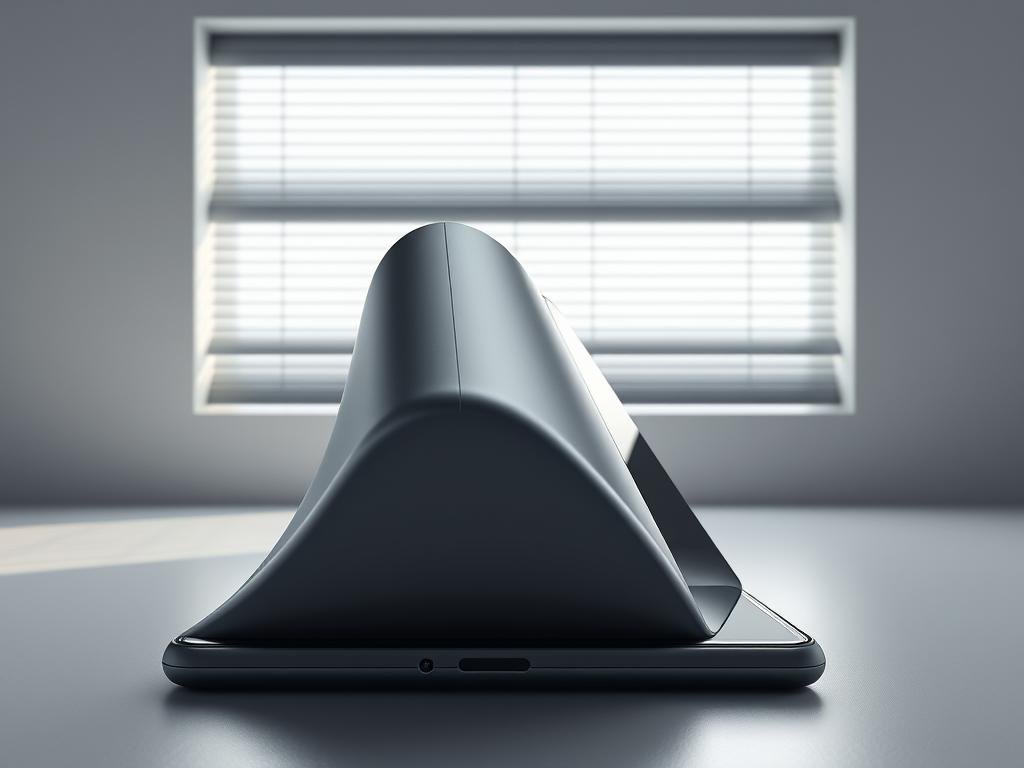
Unique Features of Rollable Technology
Rollable phones have displays that can stretch or fold. This mix of big screens and small phones is cool. They use flexible OLED displays and special hinges.
These phones are great because they are:
- Easy to carry around
- Flexible in use, big or small
- Open to new ways of using phones
Major Companies Developing Rollable Phones
Big names like Samsung and Tecno are making rollable phones. Samsung leads in display tech. Tecno shows how rollable phones are catching on.
Here’s a look at some rollable phones:
| Company | Display Size | Unique Feature |
|---|---|---|
| Samsung | Up to 7.2 inches | Dynamic OLED display |
| Tecno | Variable | Innovative retractable mechanism |
Potential Use Cases for Rollable Devices
Rollable phones are good for many things. They’re great for watching videos or browsing the web. And when you’re done, they fold up for easy storage.
“The rollable phone is not just a new form factor; it’s a new way of interacting with information and entertainment on the go.”
As rollable tech gets better, we’ll see more cool uses. These phones will change how we use our devices.
Tri-Fold Phones: A New Dimension
Technology keeps getting better, and tri-fold phones are now a reality. They offer a bigger screen than regular foldables, making them more fun to use.
How Tri-Fold Phones Work
Tri-fold phones work like regular foldables but with an extra fold. This makes them small when closed and big when opened. For example, Huawei’s Mate XT Ultimate Design has a 10.2-inch screen when open, perfect for watching videos or working.
The secret to tri-fold phones is their special hinges. These hinges make folding and unfolding smooth and strong. They’re built to last, fixing a big problem with foldables.
Design Advantages and Disadvantages
Tri-fold phones have big screens for lots of tasks. They’re great for watching videos or working on big projects. They can even replace tablets or laptops sometimes.
But, there are downsides too. Making these phones is harder and more expensive. This might make them pricier for us. Also, we’re not sure how long they’ll last.
Key benefits of tri-fold phones include:
- Enhanced multitasking capabilities
- Larger screen area for media consumption
- Increased versatility for different use cases
Current Models and Prototypes
Many companies are working on tri-fold phones, with Huawei leading the way. Other brands are also making their own versions, but most are just prototypes.
As tri-fold phones get better, we’ll see more improvements. They’re a big step forward in foldable tech, giving us more flexibility and fun in our phones.
Consumer Expectations for Foldables
People have different wants when it comes to foldables. They look at features and prices. Knowing what you want in a foldable is key.
Desired Features and Functionality
When checking out foldables, you probably have certain things in mind. Important features include:
- Durability: How well can the device handle daily use?
- Display Quality: Do you want high-resolution screens or specific sizes?
- Battery Life: Is long battery life important to you?
- Multitasking: Do you need a device for multiple tasks at once?
A foldable phone should be as useful as a portable foldable table. It should work well for both work and fun. Like how folding chairs have gotten better over time.
Price Points and Budget Considerations
Price matters a lot for foldables. You’re probably thinking about the cost versus what you get.
| Price Range | Features | Target Audience |
|---|---|---|
| $500-$800 | Basic foldable features, good display | Budget-conscious buyers |
| $800-$1,200 | Better display, more durability | Tech fans |
| $1,200+ | Premium materials, advanced features, top-notch display | Early adopters, luxury seekers |
Knowing these prices can help you decide if a foldable is for you.
Comparing Foldable, Rollable, and Traditional Phones
Exploring the future of smartphones means looking at foldable, rollable, and traditional phones. We’ll compare their features and functions. This will help you choose the best phone for you.
Size and Form Factor Differences
Foldable phones, like the Samsung Galaxy Z Flip, are small but can unfold for a bigger screen. Rollable phones are new and can change size as needed. Traditional phones stay the same size, which many people like.
These phones are like collapsible furniture. They’re small but can grow when needed. For example, foldable phones are like space-saving foldable furniture for your pocket, expanding for more use.
| Device Type | Size (Compact) | Size (Expanded) |
|---|---|---|
| Foldable Phone | 6 inches | 7.5 inches |
| Rollable Phone | 6.5 inches | 8 inches |
| Traditional Phone | N/A | 6.1 inches |
Performance and Usability
Foldable phones have improved a lot, with strong processors and lots of storage. Rollable phones are also expected to be powerful, but they’re just starting. Traditional phones are reliable but not as strong as the others.
For more on foldable vs. traditional phones, check out Honor’s blog. It gives a detailed look at the differences.
“The future of smartphones lies in their ability to adapt to our needs, and foldable and rollable phones are at the forefront of this innovation.” – Tech Expert
Long-Term Viability
Durability is key for foldable and rollable phones, as their designs are new. Traditional phones are known for being durable. But, tech changes fast, making traditional phones outdated quickly.
In summary, comparing these phones shows their unique features, performance, and durability. Knowing these differences helps you choose the right phone for your life.
Future Innovations in Foldable Technology
Foldable technology is changing fast, with new ideas coming up all the time. We’re seeing better displays, new hinge designs, and stronger devices. These changes are making our devices more useful and fun to use.
The future of foldables is about more than just making things better. It’s about creating new shapes and sizes that make our lives easier. One big trend is rollable phones. They offer more screen space without making the phone bigger when folded.
Emerging Trends to Watch
Several key trends are shaping the future of foldable technology:
- Advancements in display materials for improved durability and flexibility
- Innovative hinge designs that enhance device stability and user experience
- Development of new form factors, such as tri-fold phones
- Enhanced software optimization for foldable devices
These trends are making foldables better and opening up new uses. For example, compact foldable designs could change how we use laptops and tablets.
Potential Impact on Other Devices
The progress in foldable tech will affect other areas of the tech world. For example, better flexible displays could lead to new wearables or smart home gadgets.
| Device Type | Potential Impact | Timeline |
|---|---|---|
| Smartphones | Enhanced multitasking, larger screens | 2024-2025 |
| Laptops and Tablets | More portable, versatile designs | 2025-2026 |
| Wearable Devices | Flexible, more functional wearables | 2026-2027 |
As foldable tech gets better, we’ll see more devices benefit from these changes. We’ll see everything from rollable phones to laptops with foldable screens. The future of tech is looking very flexible.
What Should You Consider Before Buying a Foldable?
Thinking about getting a foldable phone? It’s important to know what to look for. The market for versatile foldable products is growing fast. There are many options for different needs and likes.
Assessing Your Needs and Lifestyle
Think about how you’ll use your foldable. If you like to do many things at once, find a model that can handle lots of apps. If you want something easy to carry, check the folded size and weight.
- Think about your daily life and how a foldable can make things better for you.
- Make sure the device is tough enough for your lifestyle.
Evaluating Long-Term Value
Foldable phones are new, so think about their long-term value. Look at the maker’s history with innovative folding solutions and their support for updates.
“The future of smartphones is not just about larger screens; it’s about creating devices that adapt to our needs.”
Also, think about the resale value and repair costs. This will help you understand the long-term cost of your purchase.
Where to Find the Best Deals
To save money, compare prices and look for deals. Check prices on manufacturer sites, carrier stores, and online. This way, you can find the best deals.
Also, read reviews and compare models. This will help you find the best mix of features and price for your versatile foldable products.
Conclusion: Are We Ready for Foldables?
Foldable phones are changing how we use technology. In 2022, about 4.7 million people in the U.S. used them. This is about 1.5 percent of all smartphone owners. You can learn more on AARP’s website.
Key Takeaways
Foldables are great for being portable and multitasking. They fit well into busy lives. But, they face issues like durability and software problems.
What’s Next for You?
Thinking about getting a foldable? Consider what you need and how you live. By 2027, over 100 million foldables will be sold worldwide. It’s a good time to see how they can change your life, even as a portable desk.
FAQ
What is a foldable phone?
A foldable phone has a flexible display that can bend. This makes it more compact and opens up new ways to use it, like with compact designs.
What are the benefits of using a foldable phone?
Foldable phones are great because they’re easy to carry and multitask. They offer a fresh way to interact with your device, fitting your needs perfectly.
Are foldable phones durable?
Foldable phones are getting better at being durable. But, they can break, mainly around the hinge. This is something to think about when deciding if they’re right for you.
What is a rollable phone?
A rollable phone has a display that rolls up or down. This makes it small when not in use but big when you need it, using cool tech.
How do tri-fold phones work?
Tri-fold phones fold in different ways, like zig-zag or accordion. This makes them super small and can have a big screen, showing off new ideas.
What are the advantages of tri-fold phones?
Tri-fold phones are tiny and can have big screens. They offer new ways to use your phone, making them a top choice for those who want the latest tech.
Are foldable phones more expensive than traditional smartphones?
Yes, foldable phones cost more. This is because they use special tech and materials, making them a big investment.
What should I consider before buying a foldable phone?
Think about what you need and if it’s worth the cost. Look for deals and consider durability, software, and price before buying.
How do I care for my foldable phone?
Handle your foldable phone gently and avoid too much stress. Follow the maker’s care tips to keep it in good shape, like a chair.
